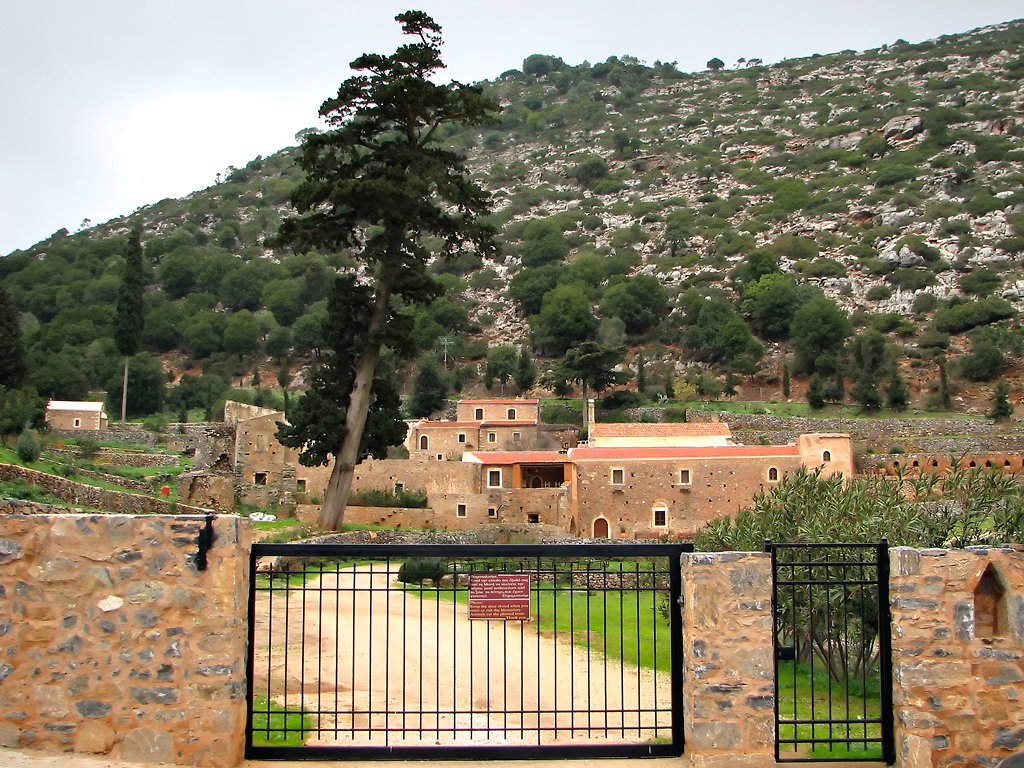- Moni Vossakou
thumb|350px|General view of the Vossakou monasterywith the imposing cypress-tree.Moni Vossakou ( _el. Μονή Βωσάκου also misspelled as Βοσάκου) is a 17th centurymonastery situated in the Mylopotamos region of the
Prefecture of Rethymno in central northCrete . The monastery isroughly 50 km east ofRethymno and is built in an area of unique natural beauty locatedon the north slope of a plateau in the Tallaia mountains. Its name stands for theox-fold, composed from the Greek words "βούς" (ox) and "σηκός" (fold) ("σακός" in theDoric Greek dialect).History
According to various historical sources, the monastery was in continuous use from the early 17thcentury until 1960, when the last of its monks passed away. In April 1676, Vossakosbecame a Patriarchical monastery (i.e.
stauropegic ), proclaimed by an act (sigillion) ofEcumenical Patriarch Parthenius IV . The monastery played an important role in the greaterarea of Mylopotamos and owned many pieces of land as well as establishments in the nearby villagesofSisses ,Garazo andDafnedes . It also strenuously contributed to the
Greek Revolution of Independence in 1821 and the Cretan Revolution of 1866. This involvement resulted inthe monastery being partially destroyed by the Turks. Later in the 19thcentury, the monastery was rebuilt through significant construction activities. The current mainchurch (katholikon ) was built in 1855, replacing an earlier one dating from the 14th and15th centuries. The church is devoted to the Holly Cross ( _el. Τίμιος Σταυρός) and celebrateson September 14th each year.Architecture
The monastic complex is arranged in three wings around the main church which is situated on theeast side of the central yard. It is a single-
aisle d, vaultedchurch that is characterized by simple artistic features. A fountain built in 1673 is locatednear the main church. The monastery's water supply system is complemented by two water-cisterns ,collecting the water draining from the roofs with a system of pipes. The east wing of the monasteryis determined by its monumental gate of 1669 and two small rooms. The south and west wingsare comprised of the dining hall, kitchen, honey and wax workshops and the rakidistillery. An open-airwine-press is located in the central wing.Current status
After being abandoned for over 40 years, the monastery was reinstated in 1998. An extensiverestoration project was undertaken by the 28th Ephorate of
Byzantine Antiquities, fundedby the municipality ofKouloukonas , the Region of Crete and the monastery itself. Today,about two thirds of the originally derelict buildings have been restored and works are stillunder way.ources
*Part of this text was adapted from that found in the monastery's leaflet, written by Kostas Giapitsoglou.
External links
* [http://www.kouloukonas.gr/portal/index.php?id=54,94,0,0,1,0 Images from the Kouloukonas municipality site]
Wikimedia Foundation. 2010.

